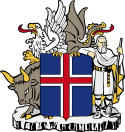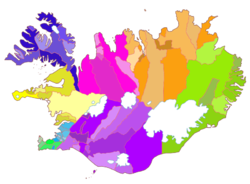- Municipalities of Iceland
-
The municipalities of Iceland are local administrative areas in Iceland that provide a number of services to their inhabitants such as kindergartens, elementary schools, waste management, social services, public housing, public transportation, services to senior citizens and handicapped people. They also govern zoning and can voluntarily take on additional functions if they have the budget for it. The autonomy of municipalities over their own matters is guaranteed by the constitution of Iceland.
Contents
History
Iceland 
This article is part of the series:
Politics and government of
IcelandConstitutionInstitutionsDivisionsForeign Affairs
The origin of the municipalities can be traced back to the commonwealth period in the 10th century when rural communities were organized into communes (hreppar) with the main purpose of providing help for the poorest individuals in society. When urbanization began in Iceland during the 18th and 19th century, several independent townships (kaupstaðir) were created. The role of municipalities was further formalized during the 20th century and by the end of the century there was no longer any distinction made between urban and rural municipalities.
The trend in recent years has been to transfer more functions and power from the state to the municipalities. This has called for larger municipalities. The government encourages municipalities to merge but has taken a different approach to the issue than governments in other Nordic countries where forced amalgamation is regularly carried out (such as the municipal reform in Denmark that took effect in 2007). Instead the process is voluntary. Municipalities negotiate possible mergers between themselves and the merger has to be agreed upon by the people of each municipality in a referendum. A similar approach is used by the Faroese government. Municipalities with fewer than 50 people may be merged with others by force though.
The number of municipalities peaked in the mid-20th century. There were 229 of them in 1950.[1] In 1995 their number had reduced to 170. In the year 2000 the number of municipalities in Iceland was 124 but after the Municipality election in 2010 the number was down to 76.[2]
Government
The municipalities are governed by municipal councils which are directly elected every four years. Municipal elections were last held on May 29, 2010. The sizes of these councils vary from five members in the smallest municipalities to fifteen in the largest one. Most municipalities except for the very small ones hire an executive manager who may or may not be a member of the municipal council. These managers are usually referred to as mayors (bæjarstjóri / borgarstjóri) in the mostly urban municipalities but "commune manager" (sveitarstjóri) in the rural or mixed municipalities.
List
Following is a list of Icelandic municipalities ranked by population in January 2011,[3] showing that urbanization is still going on. In population of the municipalities ranges from 52 to about 119,000, and by area they range from 2 km² to 8917 km². The average population in January 2011 is 4190.[3]
- Salmon-coloured cells show a decrease in population of the municipality.
- Light green cells show growth.
Rank Municipality Population
Jan. 1, 2011Change since
Jan. 1, 2010Growth
percentageTotal Iceland 318452 822 +0.26% 1 Reykjavík 118898 572 +0.48% 2 Kópavogur 30779 422 +1.39% 3 Hafnarfjörður 26099 186 +0.72% 4 Akureyri 17754 181 +1.03% 5 Reykjanesbær 13971 -120 -0.85% 6 Garðabær 10909 266 +2.50% 7 Mosfellsbær 8642 89 +1.04% 8 Árborg 7827 16 +0.20% 9 Akranes 6623 74 +1.13% 10 Fjarðabyggð 4583 -58 -1.25% 11 Seltjarnarnes 4320 -75 -1.71% 12 Vestmannaeyjar 4142 7 +0.17% 13 Skagafjörður 4110 -21 -0.51% 14 Ísafjarðarbær 3824 -75 -1.92% 15 Borgarbyggð 3476 -66 -1.86% 16 Fljótsdalshérað 3401 -66 -1.90% 17 Norðurþing 2905 -21 -0.72% 18 Grindavík 2821 -16 -0.56% 19 Álftanes 2484 -39 -1.55% 20 Hveragerði 2316 25 +1.09% 21 Höfn (Hornafjörður) 2119 33 +1.58% 22 Fjallabyggð 2030 -36 -1.74% 23 Dalvík 1960 11 +0.56% 24 Ölfus 1915 -37 -1.90% 25 Rangárþing eystra 1741 -4 -0.23% 26 Snæfellsbær 1723 21 +1.23% 27 Sandgerði 1683 -27 -1.58% 28 Rangárþing ytra 1523 -20 -1.30% 29 Garður 1452 -63 -4.16% 30 Vogar 1161 -45 -3.73% 31 Húnaþing vestra 1122 6 +0.54% 32 Stykkishólmur 1100 8 +0.73% 33 Eyjafjarðarsveit 1025 0 0.00% 34 Þingeyjarsveit 944 2 +0.21% 35 Bláskógabyggð 935 0 0.00% 36 Blönduós 904 22 +2.49% 37 Grundarfjörður 903 -1 -0.11% 38 Vesturbyggð 890 -45 -4.81% 39 Bolungarvík 888 -82 -8.45% 40 Hrunamannahreppur 795 7 +0.89% 41 Dalabyggð 684 -10 -1.44% 42 Seyðisfjörður 668 -38 -5.38% 42 Vopnafjörður 668 -15 -2.20% 44 Hvalfjarðarsveit 617 -7 -1.12% 45 Hörgársveit 600 -7 -1.15% 46 Flóahreppur 594 -8 -1.33% 47 Skagaströnd 530 11 +2.12% 48 Langanesbyggð 505 -16 -3.07% 48 Skeiða- og Gnúpverjahreppur 505 -12 -2.32% 50 Strandabyggð 501 -7 -1.38% 51 Mýrdalshreppur 469 -41 -8.04% 52 Djúpivogur 447 4 +0.90% 53 Skaftárhreppur 446 1 +0.22% 54 Húnavatnshreppur 417 -14 -3.25% 55 Svalbarðsstrandarhreppur 400 -13 -3.15% 55 Grímsnes- og Grafningshreppur 400 -15 -3.61% 57 Skútustaðahreppur 386 12 +3.21% 58 Grýtubakkahreppur 334 -3 -0.89% 59 Tálknafjarðarhreppur 306 7 +2.34% 60 Reykhólahreppur 278 -13 -4.47% 61 Kjósarhreppur 210 13 +6.60% 62 Akrahreppur 205 -4 -1.91% 63 Breiðdalshreppur 199 -11 -5.24% 64 Ásahreppur 194 4 +2.11% 65 Súðavík 192 -10 -4.95% 66 Borgarfjarðarhreppur 141 7 +5.22% 67 Eyja- og Miklaholtshreppur 135 -4 -2.88% 68 Kaldrananeshreppur 106 -6 -5.36% 68 Svalbarðshreppur 106 -5 -4.50% 70 Skagabyggð 105 -1 -0.94% 71 Bæjarhreppur 100 4 +4.17% 72 Fljótsdalshreppur 80 -9 -10.11% 73 Helgafellssveit 61 -2 -3.17% 74 Skorradalshreppur 57 -4 -6.56% 74 Tjörneshreppur 57 1 +1.79% 76 Árneshreppur 52 2 +4.00% See also
References
- ^ http://www.samband.is/media/enska/sameining-sveitarfelaga-1950-2010_Engl.pdf
- ^ The Association of Local Authorities in Iceland Retrieved June 14, 2010
- ^ a b Statistics Iceland - Population of Municipalities Retrieved Feb 28, 2011
External links
Articles on second-level administrative divisions of European countries Albania · Armenia2 · Austria · Belgium · Bosnia and Herzegovina · Bulgaria · Croatia · Cyprus2 · Czech Republic · Denmark · Estonia · Finland · France · Georgia3 · Germany · Greece · Hungary · Iceland · Italy · Kazakhstan · Kosovo4 · Latvia · Lithuania · Luxembourg · Malta · Moldova · Montenegro · Netherlands · Norway · Poland · Portugal · Romania · Russia · Serbia · Slovakia · Slovenia · Spain · Sweden · Switzerland · Turkey1 · Ukraine · United Kingdom
1 Has part of its territory outside Europe. 2 Entirely in West Asia, but considered European for cultural, political and historical reasons. 3 Partially or entirely in Asia, depending on the definition of the border. 4 Partially recognised.Table of administrative country subdivisions by country Categories:- Municipalities of Iceland
- Subdivisions of Iceland
- Municipalities by country
- Lists of municipalities
- Lists of country subdivisions
- Country subdivisions of Europe
- Second-level administrative country subdivisions
- Iceland-related lists
Wikimedia Foundation. 2010.

